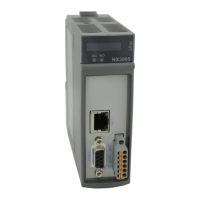6. REDUNDANCY WITH NX3030 CPU
6. Redundancy with NX3030 CPU
6.1. Introduction
This chapter describes the Nexto Series CPUs redundancy which can only be used with the NX3030 CPU.
Nexto’s redundancy is of the hot-standby type, thus, the controllers are doubled. One controller is normally in active state
and controlling a process, while the other is normally in stand-by state, keeping the synchronism with the active controller. In
case of a failure in the active controller damaging its process control, the stand-by controller switches automatically to Active,
within a very short time, in order not to disturb the process and cause any discontinuities in its outputs.
The hot-standby redundancy is a method used to increase failure tolerance and, consequently, increase the availability of
automation systems. The basic idea is to ensure that no simple failure in duplicated components causes the process control
interruption.
The hot-standby redundancy is applied on:
Oil exploration platforms
Energy generation and distribution plants
Security interlock (Instrumented Security Systems)
Continuous processes such as chemical plants, oil refinery, paper production, etc.
In the Nexto Series CPUs hot-standby redundancy, as it has already been described, the controllers are doubled. Besides,
the field buses (PROFIBUS-DP) can also, optionally, be doubled, as well as the Ethernet supervisory networks and the Ethernet
HSDN (High Speed Deterministic Network) control networks. By choosing the networks duplication, the availability becomes
even higher.
The Nexto Series CPUs hot-standby redundancy is not applied to I/O modules. In case the I/O module redundancy is
desired, it can be treated by the user in the application level. For instance, the user can duplicate or even triplicate an analog
input module and create a vote scheme to define which input will be considered in an application specific time.
The figure below shows a typical example of redundant architecture using the NX3030 CPU.
The redundant CPU central part is formed by two identical racks, called PLCA and PLCB, and a redundancy control panel
(PX2612). In the redundancy context, each rack (PLCA or PLCB) is called half-cluster, while the group formed by these two
racks is called cluster.
In this example, a PROFIBUS network, Ethernet supervision network and Ethernet HSDN control network duplication can
also be observed.
268

